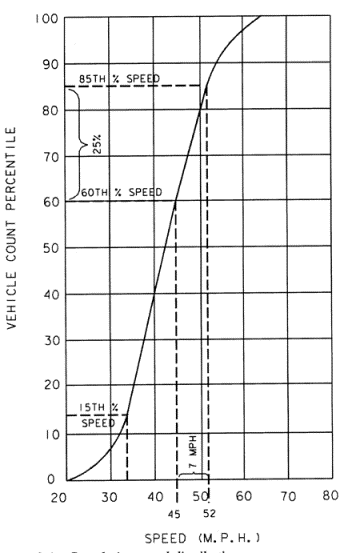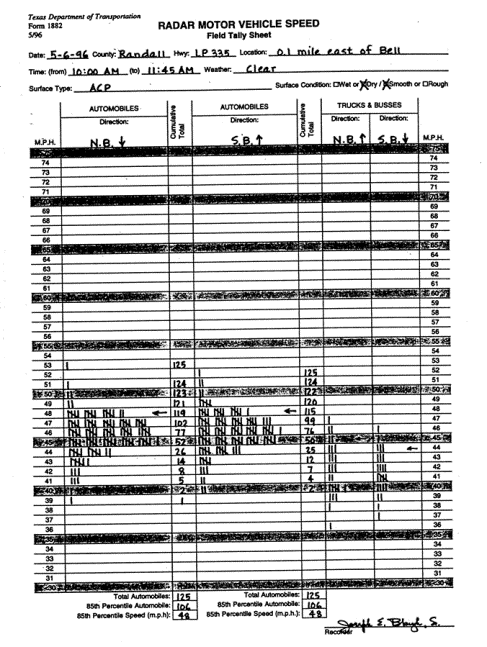Section 2: Determining the 85th Percentile Speed
Anchor: #i1002120General Concepts
The maximum speed limits posted as the result of a study should be based primarily on the 85th percentile speed, when adequate speed samples can be secured. The 85th percentile speed is a value that is used by many states and cities for establishing regulatory speed zones.
Speed checks should be made as quickly as possible, but it is not necessary to check the speed of every car. In many cases, traffic will be much too heavy for the observer to check all cars.
Anchor: #i1002130Theory
Use of the 85th percentile speed concept is based on the theory that:
- the large majority of drivers:
- are reasonable and prudent
- do not want to have a crash
- desire to reach their destination in the shortest possible time
- a speed at or below which 85 percent of people drive at any given location under good weather and visibility conditions may be considered as the maximum safe speed for that location.
Statistical Rationale
The results of numerous and extensive “before-and-after” studies substantiates the general propriety and value of the 85th percentile criterion.
Statistical techniques show that a normal probability distribution will occur when a random sample of traffic is measured. From the resulting frequency distribution curves, one finds that a certain percentage of drivers drive too fast for the existing conditions and a certain percentage of drivers travel at an unreasonably slow speed compared to the trend of traffic.
Most cumulative speed distribution curves “break” at approximately 15 percent and 85 percent of the total number of observations (see Figure 3-1). Consequently, the motorists observed in the lower 15 percent are considered to be traveling unreasonably slow and those observed above the 85th percentile value are assumed to be exceeding a safe and reasonable speed. Because of the steep slope of the distribution curve below the 85th percentile value, it can readily be seen that posting a speed below the critical value would penalize a large percentage of reasonable drivers.
Figure 3-1. Cumulative speed distribution curve
The example illustrated in Figure 3-1 shows that a speed posted for 7 miles per hour below the 85th percentile speed would unfairly penalize 25 percent of the drivers who would otherwise be considered to be driving at a reasonable and prudent speed. Therefore, for purposes of speed zoning, the maximum posted speed should be as near as possible to the 85th percentile value, and whenever minimum speed zones are used, the minimum posted speed should be within 5 miles per hour of the 15th percentile value. (See Chapter 2, Section 2, for additional information on Minimum Speed Limits. )
Experience proves these findings valid and shows that the 85th percentile speed is the one characteristic of traffic speeds that most closely conforms to a speed limit which is considered safe and reasonable.
Anchor: #i1002211Speed Checks for Existing Highways
Speed checks are of prime importance, because they:
- represent the consensus of drivers as to the safe speed at a given location
- provide the basic data on which the regulatory speed zone is based.
Speed Checks for New or Reconstructed Highways
Speed checks on new or reconstructed highway sections should not be performed until it is apparent that the traffic speeds have stabilized.
Anchor: #BABCCCGCOperation of Speed Check Stations
Normal speed checks should:
- be made on average week days at off-peak hours
- be made under favorable weather conditions
- include only “free floating” vehicles (see following paragraph)
- include a minimum of 125 cars in each direction at each station
- be discontinued after two hours if radar is used, or after four hours if a traffic counter that classifies vehicles by type is used — even if 125 cars have not been timed.
The vehicles checked should be only those in which drivers are choosing their own speed (“free floating”). When a line of vehicles moving closely behind each other passes the speed check station, only the speed of the first vehicle should be checked, since the other drivers may not be choosing their own speed. Cars involved in passing or turning maneuvers should not be checked, because they are probably driving at an abnormal rate of speed.
Trucks and busses should be recorded separately and should not be included as part of the 125-car total.
Anchor: #i1002296Location of Speed Check Stations
A complete picture of speeds in an area can only be obtained through the proper location of speed check stations. Ideally, speed checks at an infinite number of locations would be desirable; however, since this is not practical, speed check stations must be strategically located to show all the important changes in prevailing speeds.
In urban areas and on approaches to cities, speed check stations:
- should generally be located at intervals of 0.25 mile or less if necessary to insure an accurate picture of the speed pattern
- should be located midway between signals or 0.2 miles from any signal, whichever is less, to ensure an accurate representation of speed patterns
- should take into account the locality and the uniformity of physical and traffic conditions
- may be determined by trial runs through the area if volumes are too low or if a recheck of speeds is all that is needed
- should be checked midway between interchanges on the main lanes of expressways and freeways.
In rural areas, speed check stations:
- may be at intervals greater than 0.25 mile, as long as the general speed pattern is followed
- may only be necessary at each end and the middle point if the characteristics of the roadway are consistent throughout the entire section
- may be determined by trial runs through the area if the characteristics of the roadway are consistent throughout the entire section and a speed check in that section indicates that 125 vehicles cannot be checked within the two hours if radar is used, or after four hours if a traffic counter that classifies vehicles by type is used.
Measuring Speeds
Radar speed meters which operate on the radar principle are normally used for making speed checks. These devices operate from the power of an automobile battery and give direct readings of vehicle speeds in miles per hour which are accurate to within 2 miles per hour.
New technologies may be used in determining vehicular speeds for use in calculating 85th percentile speed if the measured speeds are accurate to within 2 miles per hour and the gap between vehicles is 3 seconds or greater. Examples of new technologies are counter-classifiers with the capability of classifying vehicles, determining vehicular speeds, and differentiating the gap between vehicles. These devices may include video imaging, tube counters, magnetic counters, inductive counters, etc.
Anchor: #BABEGJAARecording Measured Speeds
Use TxDOT Form 1882, “Radar Motor Vehicle Speed Field Tally Sheet,” to record tally marks beside the observed speed for each vehicle. The form is available via hyperlink (click on the form number above) or from the Traffic Operations Division.
Forms for high speed (Form 1882HS) and low speed (Form 1882LS) roads are also available via hyperlink from the Traffic Operations Division.
Figure 3-2 shows an example of a completed Field Tally Sheet.
Anchor: #i1002390Calculating 85th Percentile Speed
Use the following procedure to calculate the 85th percentile speed:
- Add the tally marks as shown in the “Cumulative Total” column in Figure 3-2. Note that the marks are added from the bottom up.
- For each “Cumulative Total” column, calculate 85 percent
of the total number of vehicles checked.
EXAMPLE: Figure 3-2 shows that 125 cars were counted in the northbound direction. So 85 percent would be 106 (125 x 0.85 = 106). Thus, the 106th car (counting up from the bottom) represents the 85th percentile speed.
- Determine the speed at which the car representing the 85th percentile was traveling. Again from the northbound example in Figure 3-2, the 106th car was traveling at 48 miles per hour. Thus, 48 miles per hour is the 85th percentile speed.
On the back of the Radar Motor Vehicle Speed Field Tally Sheet there is an “85th Percentile Calculation Table,” which may be used to readily determine the 85th percentile car if the total number is between 80 and 239.
In no case shall the 85th percentile speed be interpolated between two speeds in the M.P.H. column.
After the locations of the speed check stations have been decided upon and the speed checks have been made, the 85th percentile speeds should be calculated immediately in the field. By doing so, it is possible to get an idea of what the speed curve will look like and to determine if more speed check stations are needed.
Anchor: #i1002448Recording the Information
Record the speed check data on the strip map as described in Section 3, Developing Strip Maps of this Chapter. The blocks shown on the strip map contain the 85th percentile speed, the speed of the fastest car checked, and the number of cars checked (reading from top to bottom in order). Show a block for each speed check location for each direction of travel measured.
Figure 3-2. Example of completed Radar Motor Vehicle Speed Field Tally Sheet
Anchor: #i1002468Incomplete Data
When the data appear incomplete because of a large change in the 85th percentile speed between speed check stations or an unusually high or low 85th percentile speed at a particular point, additional speed checks should be made at new locations or repeat checks should be made at certain locations previously checked to clarify the speed picture.

